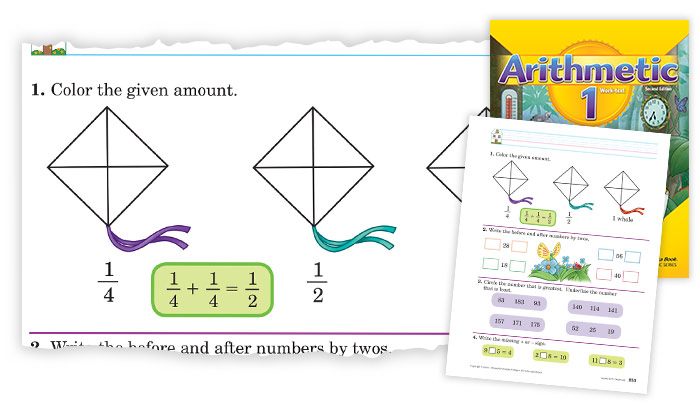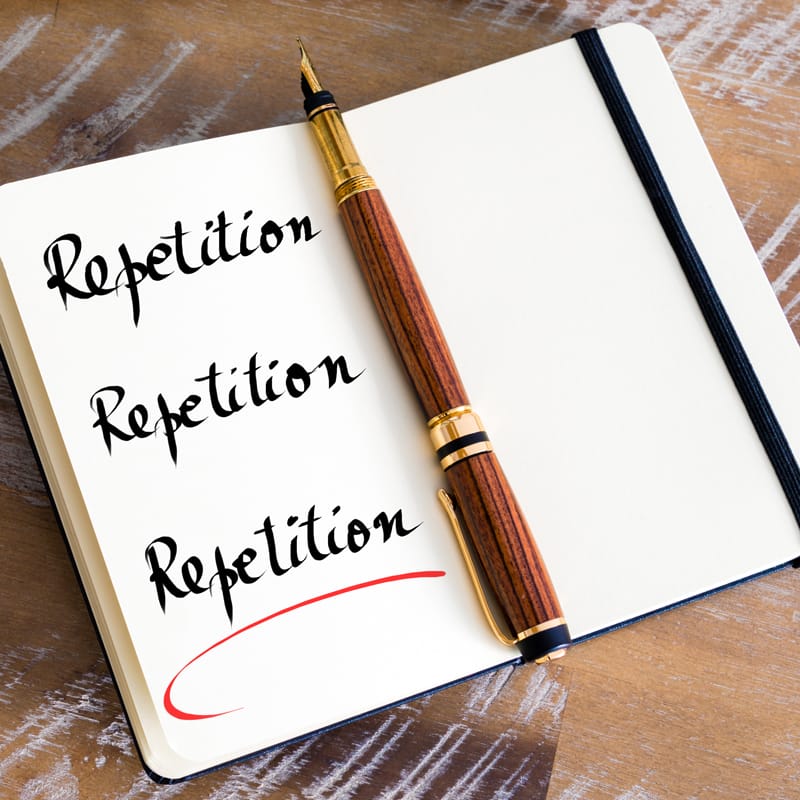If you’ve been homeschooling for a while—or even if you’re just starting—you’ve probably noticed how many approaches there are to learning. Some are fads that won’t last long. Some have been around for quite a while. Some seem to make perfect sense, and others don’t.
You may know that Abeka uses a spiral approach. Do you know why?
If not, it’s easy to find out. Just read on!
First of all, what is Abeka’s spiral approach?

What do you think of when you hear the word spiral? Maybe a spiral staircase? It’s simple, yet it’s carefully designed at the same time.
That’s kind of like our spiral approach.
Even though several elements make it so effective, it’s easy to take in at a glance. We start with the basics and build to more complexity. We use what students know to build a bridge to what they’re about to learn—with review along the way so they don’t get lost.
We don’t emphasize learning “everything” at a young age. That’s too much to take in!
Rather, we follow the more traditional approach of introducing concepts at age-appropriate times. Then, we use spiral review to reinforce and build to the next concepts.
That means the work you’re putting in right now will be valuable today—and pay off tomorrow. You’re building forward.
What does the spiral approach look like in the Abeka curriculum?
We could give you example after example of how it works, but we wouldn’t ask you to read all that. Instead, we’ll keep it simple and give you a glimpse using fractions.
We’ve highlighted new concepts added each year below, but don’t forget! Concepts already learned are reviewed each year to maintain solid footing as we step from old material to new.
-
- In kindergarten, little ones start to learn about fractions at the simplest level. They’ll shade half of a circle or learn they’d rather have a whole cookie than a half.

- In kindergarten, little ones start to learn about fractions at the simplest level. They’ll shade half of a circle or learn they’d rather have a whole cookie than a half.
In Addition to Review…
-
- First graders learn that in ¼, the 1 is how many you’re using, and the 4 is how many you have. They broaden their concept of fractions, learning ½, ¼, and ⅓ as parts of a group. Plus, they learn least to greatest and how to compare the fractions they’ve learned.

- First graders learn that in ¼, the 1 is how many you’re using, and the 4 is how many you have. They broaden their concept of fractions, learning ½, ¼, and ⅓ as parts of a group. Plus, they learn least to greatest and how to compare the fractions they’ve learned.
In Addition to Review…
-
- In second grade, they do word problems—including ones with recipes—using ½, ⅓, and ¼ and learn mixed numbers.

- In second grade, they do word problems—including ones with recipes—using ½, ⅓, and ¼ and learn mixed numbers.
In Addition to Review…
-
- In third grade, they start to explore fractions more, going from fifths to tenths, then learning to add and subtract fractions with a common denominator.

- In third grade, they start to explore fractions more, going from fifths to tenths, then learning to add and subtract fractions with a common denominator.
In Addition to Review…
-
- In fourth grade, they learn about proper and improper fractions, how to find the least common denominator, and reducing to lowest terms.

- In fourth grade, they learn about proper and improper fractions, how to find the least common denominator, and reducing to lowest terms.
In Addition to Review…
-
- In fifth grade, they learn dividing fractions.

- In fifth grade, they learn dividing fractions.
In Addition to Review…
- In sixth grade, their word problems with fractions continue to give them a broader, deeper understanding of concepts.

Of course, fractions are only a fraction of what your child will learn. To get an in-depth look at how our spiral approach plays out in every subject and every grade, you could take a look at our Detailed Scope & Sequence. If you did, you’d see new content in red and previously learned content in black. Content in red is “the next level,” but content in black will always be there to give firm footing for each new step.
What does using the spiral approach mean for your kids?
It builds confidence! They’re not always learning something new that may be difficult for them. They’re continually reminded of what they DO already know, of how their hard work to learn has paid off.
Your children get to truly understand what they study.
That time you invest in frequent, purposeful review makes facts easy to remember, even automatic. And knowing facts automatically makes learning less complicated—less frustrating.

Without those important facts mastered through the spiral approach, it’s like being asked to put a puzzle together without the key pieces.
Because of our spiral approach, students have more energy to devote to those new, more complex concepts. That basic information they have to know to figure something out? It’s right there at the forefront of their minds.
Instead of having to stop and think about 4 x 8 = 32 in a story problem, they can focus only on figuring out how to solve the problem.
An opposite to the spiral approach is the unit approach, where students study just one concept—fractions, for example—for two or three weeks. They won’t make it as far in the application because there’s not enough time. Because there isn’t review about fractions throughout the year, many students don’t remember what they learn.
What does using the spiral approach mean for you?

It means you don’t have to stress yourself out to make sure your child completely masters each concept before you move onto the next one. It means you don’t have just ONE CHANCE to “get it right.”
What you’re doing with the spiral approach is giving your child multiple opportunities to be successful.
Your child won’t see a concept only one time—or in only one way. Throughout the year, he’ll see that concept presented over and over and applied in different ways. It’ll be linked back to and reviewed, revisited instead of forgotten.
With each new “slant” in the presentation comes another opportunity to succeed.
As you teach every year, your child will meet familiar concepts and get to know them better. His grasp will continually deepen and broaden, leaving him equipped with a concrete foundation for higher-level learning.
Why else did Abeka choose our spiral approach?
1. Repetition is the key to learning.
With our spiral approach, you walk through a bit of review every day. When it comes to the end of the year, you know what you need to know. There’s no mad dash to cram in concepts your child hasn’t seen in weeks or months.
2. It guards against learning gaps.
Because you homeschool, you’ll know where your children are in their education better than anyone else does. But when you use the spiral approach, you get to be even more of an expert.
Since you’ll be reviewing and practicing and building throughout the year, you’ll know whether your children are retaining concepts. You won’t get to the end of the year, the next year, or another year down the road and realize that their understanding of basic math or grammar (though it may have been learned at one point) has been forgotten.
The spiral approach helps you guard against learning gaps from the first day you teach with it to the last.
3. It works.
“If you don’t use it, you lose it” and “Repetition is the key to learning” have been around forever. Would these old adages last so long if there were no truth to them?
But of course we can’t stop at that. We know the spiral method works because teachers trust it.
Students achieve fantastic results with it.
Decades of firsthand experience have proven it.
And research confirms it works.
According to University of South Florida Professor Dr. Howard Johnston in a brief for Education Partnerships, Inc., research on the spiral approach concludes that “activating prior knowledge, or building new learning on prior learning, produces good learning gains for almost all students, regardless of age or developmental level.”
Isn’t that what we want to see, “good learning gains . . . regardless of age or developmental level”?
But that’s not all Dr. Johnston’s research found. His brief’s conclusion says that “the spiral curriculum incorporates many research-based approaches from cognitive science that have been linked, individually, to improved student performance.”
Beyond that, research into cognitive science and master teachers’ methods also supports the spiral method.
Professor Barak Rosenshine spent much of 40 years researching what makes teaching most effective. What did he find? He shared his results in Principles of Instruction: Research-Based Strategies That All Teachers Should Know.
It states, “Education involves helping a novice develop strong, readily accessible background knowledge. It’s important that background knowledge be readily accessible, and this occurs when knowledge is well rehearsed and tied to other knowledge.”
He’s saying learners need a firm foundation of background knowledge. That’s the first step.
Then, they need to be able to grasp that background knowledge. Review it enough to remember it easily. And build on it when learning new things.
But that’s not all he said.
If you’ve stayed up at night worrying about whether you’re capable of being a good teacher for your children, take comfort in his next 3 sentences affirming that YOU ARE capable.
“The most effective teachers ensured that their students efficiently acquired, rehearsed, and connected background knowledge by providing a good deal of instructional support. They provided this support by teaching new material in manageable amounts, modeling, guiding student practice, helping students when they made errors, and providing for sufficient practice and review. Many of these teachers went on to experiential, hands-on activities, but they always did the experiential activities after, not before, the basic material was learned.”
These conclusions came from years of studying the best teachers—teachers who consistently helped all kinds of children to make wonderful strides in learning.
What these successful teachers do works, and you can do what they do.
When you’re teaching with the spiral approach, you are doing what they do!
You teach the basics. You review them. Practice them. You build on them, connecting what’s “old” with what’s new. And when it comes to help, support, and encouragement? You’ve got that covered like no one else.
In the end, we chose the spiral method because we know it contributes to success—your children’s success in learning and yours in teaching.
If you have any questions, please chat with us or give us a call at 1-877-223-5226.

Spiral review is built into Abeka's math program.
SHOP MATH



Comments for Why the Spiral Approach: Building Forward
Add A Comment
Your email address will not be published. Required fields are marked *